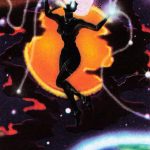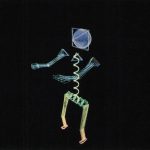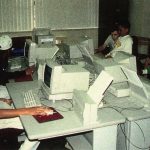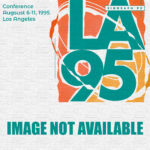SIGGRAPH 1995: SIGKids
Conference:
SIGGRAPH 1995 Co-Chair Interactive Communities:
- Coco Conn - Homer & Associates
- Rob Hennigar - DreamWorks Pictures
- Andy Goodrich - Parallax Graphics
Subcommittee Member(s):
- Jim Costigan - The Round Earth Team
- Curt Kass - Sax Arts & Crafts
- Jeffrey Mayer - Sprick Mayer & Company
- Celia Pearce - University of California, Irvine
- Jim Thompson - Tadpole Technology
- Zane Vella - Internet Tours
- Kenneth Yapkowitz - Tiger Media
Jury Member(s):
- Brian Blau - Discreet
- Jim Costigan - The Round Earth Team
- Clark Dodsworth - Osage Associates
- Enrique Godreau III - Xerox Corporation
- Jeffrey Mayer - Sprick Mayer & Company
- Kenneth Yapkowitz - Tiger Media
Overview:
At SIGGRAPH 95, Interactive Communities will explore how groups of people are using computer graphics, interactive media, and network communications to build new types of communities and engage in new forms of social interaction. This article focuses on the educational projects that will be a part of Interactive Communities in 95, both on-site at the LA Convention Center and at various other locations around the world.
The SIGKids education community will collaborate through an on-site digital production studio run by mentors and students. A SIGkids team will edit segments generated from on and off-site projects to create a daily program that will be sent out over the Internet during the week.
SNAP, the School Networking Action Project, which includes several previous SIGkids participants (The Open School, The Riverside Museum of Photography, and The Computer Access Center), will present current network projects made possible by a recent Pacific Bell CALREN (California Research and Education Network) award. For the past two years, the Riverside Museum of Photography has been working on networked exhibitions that can now be enjoyed by students via electronic field trips.
One noteworthy collaboration organized for SIGGRAPH 95 is among Martin Marietta/U.S. EPA Scientific Visualization Center, Khoral Research, DEC/San Diego Supercomputer Center, and the GLOBE Program. This Interactive Communities exhibit is designed to provide participants with an opportunity to learn how researchers, policy analysts, educators, decision-makers, and students use computer graphics and scientific computing techniques to examine environmental science concerns. The project integrates six technologies: interactive (workstation-based) scientific visualization software, multimedia tools, image processing, computational modeling (using supercomputing or parallel computing engines), data management, and high-speed networking.
Interactive Communities will also visit students at the Ralph Bunche Computer Mini-School in New York City, a participant in BBN’s National School Network Testbed which operates as a resource for solving the fundamental problems in building a universally- accessible network of K-12 schools. Students at Ralph Bunche were among the first to develop an elementary school gopher site and run a very active web server as well. Students have published their school newspaper and samples from a variety of learning projects on these servers.
Another education “community” that SIGkids will visit is the NSF-funded Collaborative Visualization (CoVis) Project, a cooperative venture of Northwestern University and several other educational and industrial partners. Participants, such as the Exploratorium in San Francisco, use high-speed telecommunications technology to support long-distance collaboration with other science centers and schools. This community of teachers, students, and science mentors uses scientific tools, shared databases, hypermedia, and linked multimedia to build Collaboratory Notebooks in open-ended science learning projects. Linked pages in their electronic notebooks guide student researchers to question, make conjectures, find evidence for and against, collect information, plan, and write commentaries that other students have access to.
At Gonzaga College High School in Washington D.C., students studying Earth Systems Science use modeling software to represent their understanding of natural phenomena. They plan to post student work on the World Wide Web using NCSA Collage and Mosaic, where visitors who have access to the Stella II modeling package, will be able to download and run the simulations.
Another featured project at Interactive Communities will be CitySpace, a virtual city built collaboratively by kids across the Internet. Launched at SIGGRAPH 93, the CitySpace project has worked with groups of SIGkids around the country as well as with young people at the Computer Clubhouse in Boston, the Exploratorium in San Francisco, and other science centers and after-school groups.
National laboratories across the country are involved in a variety of education outreach programs. Supercomputing for high school students, science and math programs for elementary school classrooms, systems theory and modeling workshops, environmental monitoring stations, and global collaborative research projects are becoming part of how students use the Internet and computers in their classrooms.
A “community” of educators, now linking up with the national labs, museums, government agencies, nonprofit organizations, and corporations can be found in New Mexico’s Rio Grande corridor. Several classes have already met each other online using CU- SeeMe video conferencing software. (The software can be acquired at ftp://gated.comell .edu/pub/video). One fourth-grade class at Alvarado Elementary School has a project called Wireless Coyote. Students do field research and take notes using Macintosh Newtons, which transmit data to portable Powerbooks in their classroom. Students conduct Internet research, and use video to create Hyperstudio multimedia presentations of class projects.
Interactive Communities at SIGGRAPH 95 will have the ambiance of a broadcast production facility crossed with an air traffic control tower. In a bustling environment of large screen projections and new media technologies, Interactive Communities 95 will serve as the nexus point for network-wide communication, linking off-site participants with visitors to SIGGRAPH. Guest DJs will orchestrate and present various projects to the onsite audience throughout the conference.
Off-site participants worldwide will connect with Interactive Communities at SIG- GRAPH 95 via large-screen projections. Another strategically placed screen will feature international maps showing the network traffic being generated during the conference. SIGKid’s KSIG digital network station will be playing the collaborative hits of the hour with guest DJs serving up the hottest pixels this side of the Rio Grande. A systems theory and modeling workshop will look at the many different approaches to using networking technologies in education, science, business, and art.












